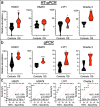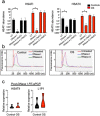Extracellular vesicle-associated repetitive element DNAs as candidate osteosarcoma biomarkers
- PMID: 33420117
- PMCID: PMC7794510
- DOI: 10.1038/s41598-020-77398-z
Extracellular vesicle-associated repetitive element DNAs as candidate osteosarcoma biomarkers
Abstract
Osteosarcoma (OS) is the most common malignant bone tumor in children and young adults. Despite that high-risk factors have been identified, no test for early detection is available. This study aimed to identify circulating nucleic acid sequences associated with serum extracellular vesicle (EV) preparations at the time of OS diagnosis, as a step towards an OS early detection assay. Sequencing of small nucleic acids extracted from serum EV preparations revealed increased representation of diverse repetitive element sequences in OS patient versus control sera. Analysis of a validation cohort using qPCR of PEG-precipitated EV preparations revealed the over-representation of HSATI, HSATII, LINE1-P1, and Charlie 3 at the DNA but not RNA level, with receiver operating characteristic (ROC) area under the curve (AUC) ≥ 0.90. HSATI and HSATII DNAs co-purified with EVs prepared by precipitation and size exclusion chromatography but not by exosome immunocapture, indicative of packaging in a non-exosomal complex. The consistent over-representation of EV-associated repetitive element DNA sequences suggests their potential utility as biomarkers for OS and perhaps other cancers.
Conflict of interest statement
D.C. and L.C. are inventors on a U.S. provisional patent, Children’s Hospital Los Angeles as applicant, relating to REPETITIVE ELEMENT DNAS.
Figures






Similar articles
-
Extracellular Vesicle RNA Sequencing Reveals Dramatic Transcriptomic Alterations Between Metastatic and Primary Osteosarcoma in a Liquid Biopsy Approach.Ann Surg Oncol. 2018 Sep;25(9):2642-2651. doi: 10.1245/s10434-018-6642-z. Epub 2018 Jul 6. Ann Surg Oncol. 2018. PMID: 29981024
-
Identification of potential extracellular vesicle protein markers altered in osteosarcoma from public databases.Proteomics Clin Appl. 2023 Jul;17(4):e2200084. doi: 10.1002/prca.202200084. Epub 2023 Jan 3. Proteomics Clin Appl. 2023. PMID: 36571514
-
Extracellular vesicles: A new diagnostic biomarker and targeted drug in osteosarcoma.Front Immunol. 2022 Sep 23;13:1002742. doi: 10.3389/fimmu.2022.1002742. eCollection 2022. Front Immunol. 2022. PMID: 36211364 Free PMC article. Review.
-
LINE-1 Methylation Analysis in Mesenchymal Stem Cells Treated with Osteosarcoma-Derived Extracellular Vesicles.J Vis Exp. 2020 Feb 1;(156). doi: 10.3791/60705. J Vis Exp. 2020. PMID: 32065171
-
Circulating and extracellular vesicle-derived microRNAs as biomarkers in bone-related diseases.Front Endocrinol (Lausanne). 2023 May 24;14:1168898. doi: 10.3389/fendo.2023.1168898. eCollection 2023. Front Endocrinol (Lausanne). 2023. PMID: 37293498 Free PMC article. Review.
Cited by
-
Extracellular Vesicle-DNA: The Next Liquid Biopsy Biomarker for Early Cancer Diagnosis?Cancers (Basel). 2023 Feb 24;15(5):1456. doi: 10.3390/cancers15051456. Cancers (Basel). 2023. PMID: 36900248 Free PMC article. Review.
-
Extracellular Vesicles in Osteosarcoma: Antagonists or Therapeutic Agents?Int J Mol Sci. 2021 Nov 22;22(22):12586. doi: 10.3390/ijms222212586. Int J Mol Sci. 2021. PMID: 34830463 Free PMC article. Review.
-
Extracellular vesicles in tumorigenesis, metastasis, chemotherapy resistance and intercellular communication in osteosarcoma.Bioengineered. 2023 Dec;14(1):113-128. doi: 10.1080/21655979.2022.2161711. Bioengineered. 2023. PMID: 37377390 Free PMC article. Review.
-
Effects of Exosomes on Tumor Bioregulation and Diagnosis.ACS Omega. 2023 Jan 31;8(6):5157-5168. doi: 10.1021/acsomega.2c06567. eCollection 2023 Feb 14. ACS Omega. 2023. PMID: 36816660 Free PMC article. Review.
-
A tailored bioactive 3D porous poly(lactic-acid)-exosome scaffold with osteo-immunomodulatory and osteogenic differentiation properties.J Biol Eng. 2022 Aug 22;16(1):22. doi: 10.1186/s13036-022-00301-z. J Biol Eng. 2022. PMID: 35996115 Free PMC article.
References
Publication types
MeSH terms
Substances
LinkOut - more resources
Full Text Sources
Other Literature Sources
Medical

